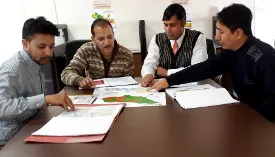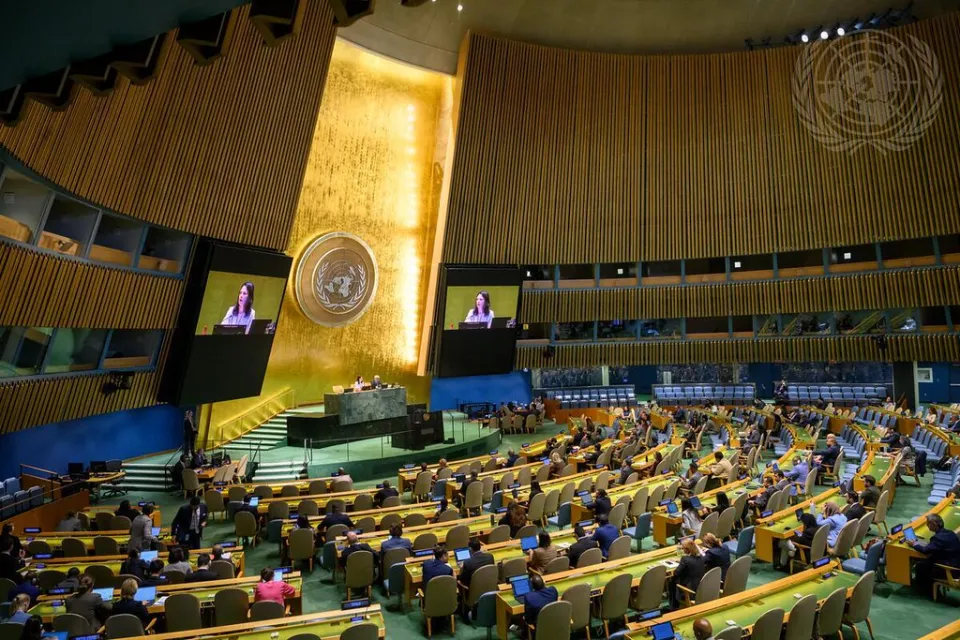Towards a robust electoral decision support system: Nepal's experiences with International IDEA ERMTool for better informed decision making

Introduction: Risk does encompass more than Violence
"The biggest risk is not taking any risk…. In a world that is changing really quickly, the only strategy that is guaranteed to fail is not taking risks." Through the above statement, Mark Zuckerberg precisely observes the importance of managing risks. Risks are not only inevitable but have become an essential part of modern day world.
Risks may crop up from almost 'any' aspect of an organization. They may arise from within the organization and could be triggered from outside. Risks may have origin in political environment, in legal framework, in administrative arrangements, in technical components, in security aspects and so on. Such risks, if not dealt with properly in planned manner, may become an impediment to an organization's objectives by sparking off incidents of violence, triggering inefficiency and educing ineffectiveness.
Risk Management process involves several activities which, in general, can be categorized into two dimensions. The first dimension incorporates activities of identifying, understanding, assessing and prioritizing the 'risks'. The other dimension includes timely instigation of coordinated efforts by taking well informed decisions and actions by the authorized body in order to deal with the risk(s). Through these activities, a risk management process enhances the informed decision-making process of an organization.
Electoral risk management entails systematic efforts undertaken to improve knowledge about electoral risk factors, and develop situational awareness needed to initiate timely and well informed preventive and mitigative actions (Alihodzic). An Electoral Management Body (EMB) has the sole purpose of conducting elections and other direct democracy instruments. Such events include possibilities of confrontations, time pressures, uncertainties, allocative deficiencies and other negative consequences. The Electoral Risk Management (ERM) process attempts to manage such risks throughout all phases of electoral cycle (pre, during and post election phases) and ameliorate the decision-making process of an EMB.
ERMTool Project in the ECN: Focused primarily on electoral violence
Subsequent to a context overview workshop in March 2013, The Election Commission, Nepal (ECN) initiated an ERMT Project in May 2013 with support from International IDEA. Through this project, Electoral Risk Management (ERM) methodology was initially introduced in the ECN using International IDEA’s ERMTool. Since the methodology of ERMTool was flexible, ECN was able to customize the tool to local realities and continue to use it as a key instrument of the ECN ERM work.
The tool was used to identify incidents related to electoral violence and to create election risk maps as well as trend charts and analyses based on data collected from several sources. Through the analysis of the incidents, suggestions were provided to the ECN for appropriate actions to prevent and/or mitigate the electoral risks in the next Constituent Assembly (CA) Elections, 2013.
About 40 alerts on physical and psychological risks were issued during the election phase which helped ECN to visually understand the prevailing risk scenario and take appropriate actions timely on the alerted areas. Notably, the CA Elections 2013 were concluded peacefully with a highest voter-turnout (78.34 per cent in First Past the Post electoral system) in the electoral history of Nepal. Similarly the ERM team proactively analysed the electoral risks during the CA By-Elections, 2014. During that period, the team issued 12 risk alerts and suggested appropriate actions for the ECN to prevent and mitigate the electoral violences.
All the risk measures including suggestions and the actions taken have been documented in the Risk and Actions Register (RAR) in the ERMTool. The ECN felt that the tool can be meaningfully used by the commission for effortlessly understanding the situation and generate optimum decision alternatives with the analysed information.
Institutionalization of ERM System within ECN: Utilizing ERMT in electoral decision-making process
A review meeting was held in April 2014, in Kathmandu in order to appraise the performance of the ERM project. Through the meeting ECN summed up that the implementation of the ERMTool throughout the whole electoral cycle would be crucial. Recognizing the importance of electoral risk management system for the better informed electoral decision making, ECN decided to institutionalize the ERM system. For this, ECN decided to establish ERM Unit under its organization structure in May 2014.
ECN understands that institutionalizing the ERM system primarily includes the following tasks:
- incorporating ERM function within the organization structure
- creating legal and procedural framework in order to make the system work
- determining and allocating the 'internal' physical and human resources
- clarifying the roles, responsibilities, authorities and accountabilities of the unit staff
- generating ownership of the EMB for sustainably utilizing the system
- ensuring the effective and efficient operation of the system through training and capacity building of ECN staff down to district level
In this process, ECN has been moving forward in a planned way. A summary of current proceedings has been presented below:

The Unit: Electoral Risk Management Unit (ERMU) has been put into operation within ECN. To make the unit viable and sustainable, only two ECN staff (a Unit Incharge and a Computer Operator/data analyst) have been assigned to work full time for the unit and ECN assumes to assign more data analysts for short-term as deemed necessary (e.g. during election periods). For smooth transfer of knowledge and to build long term capacity of the ECN, ERMT will continue to receive professional support from International IDEA. An appropriate office space has been allocated and basic equipments and tools are available in the unit.
Risk Roster: Risk Factors were identified specifically for CA Election and by-election purposes. However, for the unit to effectively contribute to the decision-making process of ECN in a better informed way, the ERMU is now in the process of identifying the general risk factors and maintaining a comprehensive "Risk Roster" in the unit.
Stakeholders Engagement: ERMU realizes that for effective operation of the unit, a systematic coordination with the electoral stakeholders is very important. Therefore, continuous identification of and engagement mechanism with the stakeholders is being worked out.
Data Management Apparatus: ERMU is currently brainstorming on a systematic data collection apparatus, with which the electoral stakeholders could be linked, including establishing a two-way data-communication. The system also envisions to embed the risk management system with a centralized electoral database housed at ECN's Data Center. Possible technical/financial assistance from the partners in this regard is being looked at.
ERMT Contextualization: The knowledge resource section available in the ERMT includes vast knowledge of electoral experiences from around the the globe. ERMU is planning to gather information on Nepal's past electoral experiences, problems faced and the way the problems were dealt with and feed this information in the tool. This would ease the unit to analyse the risk‑scenario through the local perspectives and provide more practical feedback to the ECN.
Decision Support System: The ERMU team has been regularly identifying risk sources in the 'pre' and 'post' election scenario of an EMB. The unit is periodically (at least once a month) presenting risk analysis to the commission. Notably, the maps and analysis documents are all prepared in native (Nepali) language. ERMU feels that this has increased relevancy and legibility of the content, and elevated the interest of decision-makers in the reports. This has ultimately helped them to become well-informed on the issue before making the decisions. Below are key highlights of some of the risk reports recently presented to the Commission:
- Status of vacant positions in the district offices of ECN and its possible negative impact on ECN objectives
- Physical Infrastructure mapping and possible measures for better efficiency of the ECN
- A comparative analysis of voter turnout and invalid votes in the last two nationwide elections
- Feedback to ECN on remodeling voter-education as well as voter-registration programme
- An analysis of voters' concentration in each of the districts and reflecting that half of the total number of voters in Nepal are located in only 20 (out of 75) districts
- An analysis of presumed number of new voters to be registered in each districts of Nepal on the basis of recent National Census and alert to ECN on possible huge number of new registrants which could be almost about half of the current number of voters. (the second page of the report is presented below)

Challenges faced and Lessons learnt
While institutionalizing the ERM system, ECN faced some difficulties as well as challenges. Some of them have been outlined below:
- Risk Management is not considered as a priority function by the organizations especially in developing countries
- Decision making is mostly considered as a 'secret' function in the organization and decision makers are reluctant to the use of modern tools and technology in the process
- There is always suspicion among the partner organizations to reveal data. This scenario is more relevant in the case of data from security sector agencies
- Creating ownership within an EMB is found to be challenging. Getting prompt response from internal departments and field offices requires a continuous effort from the unit.
- Establishing a systematic collaboration among stakeholders is not so easy
- Verifying data from magazines, television and other sources is always a crucial function. There are high chances of subjectivity of the data analyzer
- Implementation of ERMU recommendation depends on EMB's willingness and capacity
- Institutional memory will be always at risk if ERM system is not internalized and is not run with permanent EMB staff
Dealing with those challenges, some of the lessons learnt have been presented below which could be of use for the other EMBs who intend to implement the ERMTool.
- Institutionalization process requires 'deep' understanding and ownership by the policy level officials at the EMB.
- Clear legal/procedural backup and allocation of permanent staff is required for sustainability of the ERM system.
- Risk data-sources need to be comprehensively identified in advance and, nevertheless, this is a dynamic process.
- Data collection 'success' depends upon clear procedure and good personal/organization relationship with the stakeholders.
- Use of Information and Communication Technologies (ICT) is a must for timely data collection and rapid analysis/feedback
- Risk Management function requires creativity, certain level of independence, self initiation and flexibility. Job descriptions are merely guiding tools.
- Reporting and discussion mechanism (of risk alerts) should be pre‑specified and unambiguous.
- GIS function and Risk Management function should be procedurally correlated and preferably integrated.
- Collaboration 'with' and 'among' development partners engaged in the electoral processes is vital for building ERM system within an EMB and for institutionalizing knowledge/technology.
ECN's Future Plan: Towards a better 'equipped' Electoral Decision Support System
Planners and decision makers in modern times are required to integrate the organization activities with the environment. For this they have to change the way they think. This can be done only by integrating the decision-making tools that build a holistic and comprehensive approach to resolving the problems. Integrating the ERMTool in Electoral decision making widens the horizon of decision makers and helps them think holistically while generating decision alternatives. Realizing this, ECN envisions to re‑mold and augment the current decision-making tradition with "Graphic plus Geographic" visualization and transform its approach into a systematic informed decision-making process. For this to happen below are some snapshots of its future plans:
Ensuring Proficient and Integrated Operation of the ERM System
ECN is currently in the process of revising its organization structure in line with its Second Strategic Plan (2015-2019). ECN assumes to have an integrated functional structure of ERM system, GIS system and electoral information system together in order to utilize the systems better collectively in decision-making processes. Operation procedures will be implemented and corresponding job descriptions will be finalized and assigned. Possible collaboration with partners will be looked at for better equipping the ERMU with enhanced knowledge and technology.
Instituting Data Management Apparatus
Identification of stakeholders, orienting them with the ERM system and linking them through an ERM data management apparatus is one of the future plans of the ECN. If this plan materializes, central ERM data depository will be connected to every district offices and other stakeholders. Such Data Management Apparatus will be of key resource in making decisions at the center taking all country-wide data into account.
Decentralizing ERM system and integrating with Center
The recent training on ERMTool and GIS imparted to all 75 District Election Officers (DEOs) of Nepal was an important step towards institutionalizing the system at local (District) level. DEOs showed keen interest in utilizing the tools at local level. More importantly, the existing human resources in the district offices would be able to operate the tools and use in district level decision-making processes without any major additional long term costs. So, ECN envisages decentralizing the ERM system to district level and integrating them with the central ERM system. This initiative will work beautifully together with the Data Management Apparatus mentioned above.
Customizing and utilizing Electoral Knowledge Resources
Existing electoral knowledge resource library of ERMT will be customized to augment it with Nepal's past electoral experiences as well as social and geo‑political scenario of the country.
Establishing Global ERM Knowledge Hub
ECN is initiating to build, retain and continually enrich the institutional memory of ERM. By ensuring proficient functioning of the ERM Unit, ECN envisages to develop and champion in the unmatched ERM competency in Electoral Risk Management. ECN/ERMU plans to develop itself as a "Global ERM Knowledge Hub" conceiving a forum for ERM knowledge management, experience sharing, research and development.
Concluding Abstract
Due to critically scheduled time frames, politically charged atmospheres, and utterly sensitive electoral processes; EMBs are prone to risks in their almost every endeavor. Proactively and incessantly analyzing the sources of risk with the aid of modern tools and taking informed decisions based on those analyses would significantly improve the quality of their performances. Recognizing this fact, ECN has initiated the Electoral Risk Management system within the organization using the ERMTool and the system is now being institutionalized. Seeing that managing risks is a rationale as well as a constituent of the decision-making process, ECN is remolding the current decision-making tradition towards a systematic informed decision-making process through integrated use of the ERM System, GIS System and Electoral Information System. To achieve this, ECN has been moving forward in a planned way which includes several activities such as institutional arrangements, capacity development, stakeholder engagement, integrated data management, contextualization of the tools and so on. Ultimately, ECN envisions developing and globally championing the unmatched ERM competency.
References:
Alihodzic, S., (2014, February), Building resilience to electoral risks. Published in: ACE Newsletter May 2015, ACE Electoral Network.
An Overview of the Electoral Risk Management Tool (ERM Tool). (2013). Stromsberg, International IDEA.
Abukhater, A., (2011, January 2). GIS for Planning and Community Development: Solving Global Challenges. Directions Magazine. Retrieved from http://www.directionsmag.com/entry/gis-for-planning-and-community-development-solving-global-challenges/149245
ISO 31000:2009 - Risk management -- Principles and guidelines. (2013, December 18). Retrieved from http://www.iso.org/iso/catalogue_detail.htm?csnumber=43170



